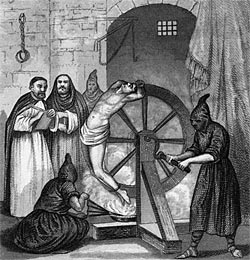Middle Age Torture Tactics
Execution By The Wheel
This form of torture, also sometimes known as the Catherine Wheel or the Breaking Wheel, was a form of capital punishment that resulted in the criminal's death. It originated in Ancient Greece, and was commonly used there, as well as in modern day France, Sweden, Russia, and Germany. The wheel execution was used as recently as the nineteenth century. Throughout history, this form of torture has sometimes been referred to as the most brutal, although the quartering execution may be worse. The victim involved in this torture was cudgeled to death.

Usually, the wheel consisted of a large wooden wheel with radial spokes. Sometimes, the condemned person would be cudgeled to death upon the wheel, as the spokes allowed a club or cudgel to pass through it. Other times, the victim was nailed to a wooden 'X' (called a Saint Andrew's Cross) and their body would be displayed on the wheel after their death. Usually however, and most often in France, the condemned would be stretched out along the spokes of the wheel, and revolved slowly, being beaten by an iron hammer through the gaps in the spokes and breaking the bones. To be 'merciful', sometimes the executioner would administer 'coups de grace', in which the victim would recieve blows to the chest and stomach, causing fatal injuries and a relatively quick death. If not, the person would die from shock and dehydration some time later.
